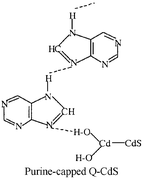Synthesis and photophysics of purine-capped Q-CdS nanocrystallites
Abstract
Purine-capped Q-CdS has been synthesised in aqueous basic medium in the presence of excess Cd2+. XRD analysis suggests the presence of CdS is in both its cubic and wurtzite structural forms along with Cd(OH)2. IR and NMR studies indicate core CdS binds purine through H-bonding interaction involving the OH of Cd(OH)2 and N(9) of purine. A further uptake of purine occurs through protonated N(7). The amount of purine controls the size of the clusters in a dynamic equilibrium. These clusters exhibit size-dependent electronic properties. Purine binds to the deep defects involved in non-radiative transition and enhances the bandgap emission. Emission decays in a complex process and consists of three distinct time domains in the sub-nanosecond and nanosecond range. Relaxation kinetics of the charge carriers monitored as a function of emission energy reveal a distribution of traps to varying depths on the surface of the particles. These particles were highly photoactive. Their illumination results in the production of smaller particles. Thermolysis of these colloids induces the growth of particles by removing the weakly bound purine.


 Please wait while we load your content...
Please wait while we load your content...